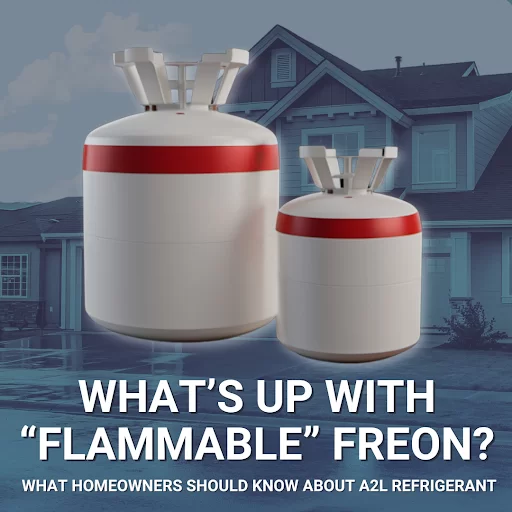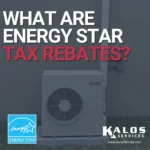HVAC systems contain a fluid called refrigerant (which some people call by the brand name “Freon”). This fluid has many properties that allow it to absorb heat and move it somewhere else to keep you cool. (Or, in the case of heat pumps, they can keep you warm by moving outdoor heat indoors.)
If you have an HVAC system installed in the last 25 years, the refrigerant is most likely R-22 or R-410A. As of 2020, R-22 can no longer be made or imported into the USA, and R-410A is currently going through a phasedown. While we can still get our hands on stockpiled R-22 and R-410A to charge existing systems, we will see A2Ls replace those in new units. A2L refrigerants have similar properties to R-410A, but they have one key difference.
A1s & A2Ls
The American Society of Heating, Refrigeration, and Air-Conditioning Engineers (ASHRAE) sorts refrigerants into categories based on two factors. This system assigns a letter (A or B) to describe toxicity and a number (1, 2L, 2, and 3) to describe flammability.
Class A refrigerants are non-toxic. These can still displace oxygen in tight spaces and make us sick from a lack of oxygen, but they don’t directly damage our respiratory systems. Class B refrigerants, like ammonia, are toxic and will make us sick.
Class 1 refrigerants are deemed non-flammable under a set of test conditions. Class 2 refrigerants are moderately flammable, and Class 3 refrigerants are highly flammable. Propane is an example of a non-toxic, highly flammable refrigerant, so it is an A3. Below is an example of an A3 in a controlled testing flask (The A1 test conditions require a flame in a controlled flask to stay within the 90-degree angle shown within.)
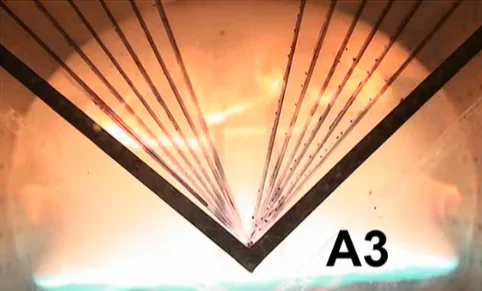
The flames of some refrigerants just barely make it past that 90-degree angle and aren’t really anywhere near the “moderately flammable” Class 2 status. We needed a new category for refrigerants that are just slightly flammable, so Class 2L was made specifically for them.
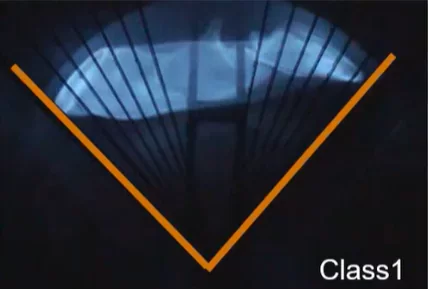
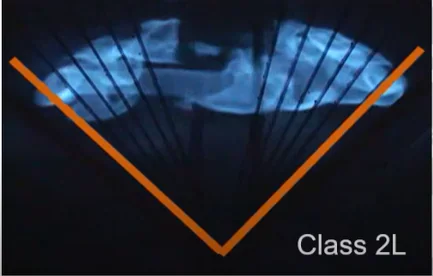
The refrigerants we’ve mostly used up to this point (R-22, R-410A, and old-school R-11 & R-12) are A1 refrigerants. We will begin to see R-32 and R-454B in residential HVAC systems; these are A2Ls.
Why Switch to A2Ls?
This century, we have used two main refrigerants in A/C systems and heat pumps: R-22 and then R-410A. However, both R-22 and R-410A are quite bad for the environment.
R-22 is a refrigerant containing chlorine (an HCFC), which depletes the ozone layer. Making and importing R-22 has been illegal in the USA since 2020. While it is still legal to own these systems and for contractors like Kalos to replenish them, we must use stockpiled or reclaimed R-22.
Meanwhile, R-410A may not deplete the ozone layer, but it is a major contributor to global warming. Its impact is 2088x greater than that of carbon dioxide. As a result, the Environmental Protection Agency (EPA) has started mandating the gradual reduction of R-410A production. The goal is to reduce production by 85% by 2036 in five stages. We are currently in stage two; production has been reduced by 40%.
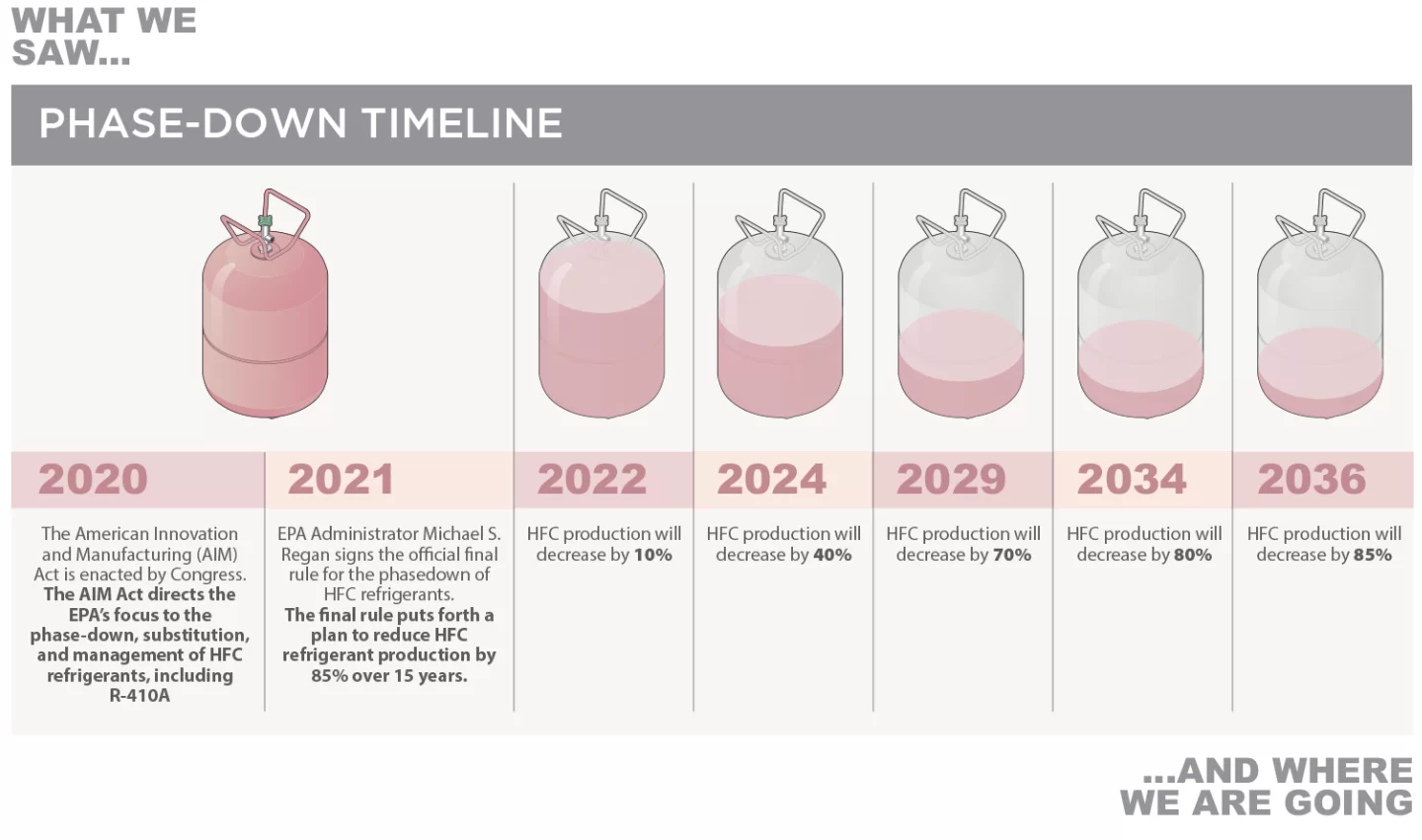
The EPA has also issued a final rule banning the manufacturing of split R-410A equipment (with a separate indoor and outdoor unit) by January 1st, 2025. However, contractors like Kalos can install these through January 1st, 2026, and parts for existing systems will remain available for as long as it makes sense to keep them on the market.
A2Ls R-454B and R-32 have emerged as replacements for R-410A in new residential HVAC units. These refrigerants are far less harmful to the environment than R-410A and R-22.
A2Ls are also not particularly new. Europe and Japan have used A2L refrigerants in their residential HVAC units for a while now. Most cars manufactured over the last decade have also used A2L refrigerants in their A/C systems. The most common refrigerant in vehicles on the road today is R-1234yf, which is also an A2L.
A2Ls and Safety
A2Ls do not contain hydrocarbons like propane and butane, which are A3 refrigerants that burn easily. They really aren’t that much different from A1 refrigerants; they offer similar efficiency rates and definitely don’t have the same risk as a furnace or gas stove. Still, the HVAC industry has taken a few safety precautions to protect technicians and you.
These new units will have a sensor that trips when it detects a leak; it will shut off the compressor but turn on the blower, which will disperse the concentration of refrigerant. A2Ls are not compatible with A1 units, so you will need to purchase a new unit when your current system’s service life is over; however, the piping can remain as is if you choose to replace your existing unit with a new one of the same size.
A spark should not ignite an A2L, but your HVAC contractor should also insulate anything electrical that could spark, including compressor wires.
A2L systems do not pose much more of a safety concern than A1 systems. You would never want to smoke or bring an open flame near your HVAC unit or any part of the system, but that is true of A1 systems as well. You’ll also want to be extra careful and avoid using electrical appliances that could spark near your HVAC system.
Conclusion
Over the next couple of years, we will see A2L refrigerants make their way into the marketplace. Starting in 2026, pretty much all new A/C systems and heat pumps will contain an A2L refrigerant—either R-32 or R-454B. A2Ls have the “mildly flammable” label because of how they respond to testing conditions—not necessarily field conditions.
However, these A2Ls are highly unlikely to ignite in your home when proper precautions are taken to keep flammable materials and sparks away from them. A new A2L-based HVAC unit won’t be much different from one that uses the R-410A we’ve been using, save for a few new safety features.
Kalos technicians have received training to work on A2L units and apply best practices to keep you and your family cool and safe.

